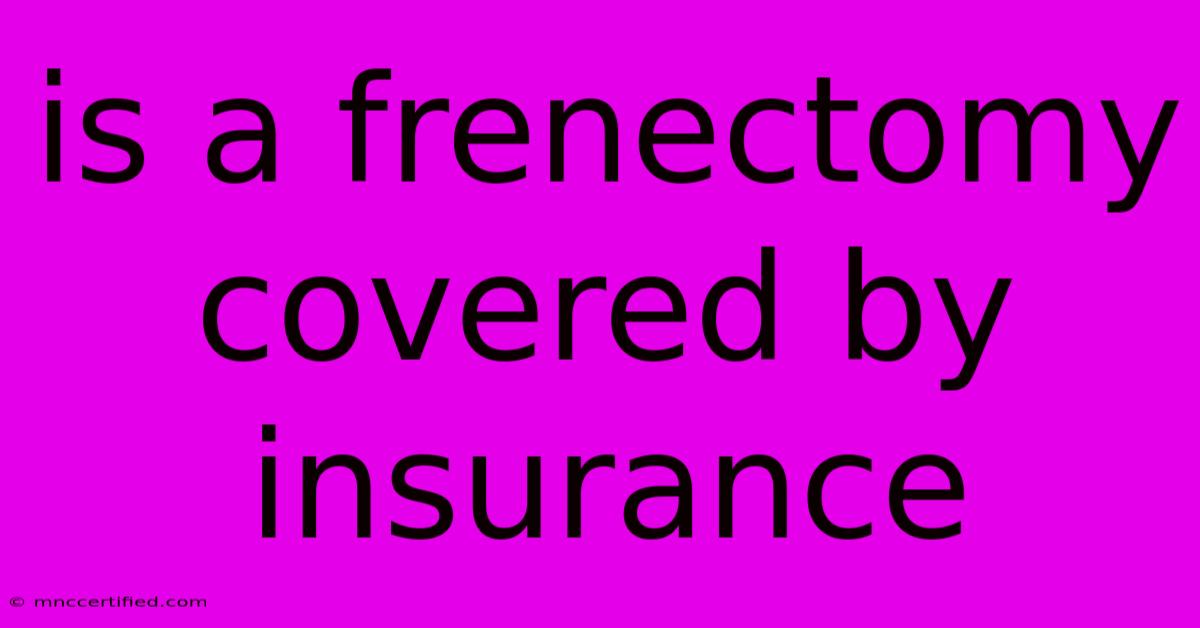Is A Frenectomy Covered By Insurance

Table of Contents
Is a Frenectomy Covered by Insurance? A Comprehensive Guide
A frenectomy is a surgical procedure to remove a frenulum, a small fold of tissue that can restrict movement of the tongue, lips, or cheeks. While this procedure can significantly improve speech, eating, and overall oral health, many people wonder: Is a frenectomy covered by insurance?
The answer is it depends. Insurance coverage for frenectomies varies widely depending on several factors, including:
- Your insurance plan: Some insurance plans cover frenectomies as a medically necessary procedure, while others may not.
- The reason for the frenectomy: If the frenectomy is performed for purely cosmetic reasons, insurance is unlikely to cover it. However, if the frenectomy is deemed medically necessary due to issues like speech difficulties, feeding problems, or dental issues, it's more likely to be covered.
- Your provider: Some insurance providers may require pre-authorization before performing a frenectomy, and others may not.
- Your location: Coverage policies can vary by state and region.
Factors That Influence Coverage
Here are some common reasons why a frenectomy might be considered medically necessary and therefore covered by insurance:
- Speech difficulties: A tight lingual frenulum can restrict tongue movement, leading to difficulty pronouncing certain sounds.
- Feeding problems: In infants and young children, a tight frenulum can interfere with breastfeeding or bottle feeding.
- Dental issues: A tight frenulum can affect tooth alignment, leading to crowding or gaps.
- Difficulty playing musical instruments: A tight labial frenulum can make it challenging to play instruments like the trumpet or flute.
How to Determine Coverage
1. Check Your Insurance Policy: Carefully review your insurance policy's coverage details for surgical procedures. Look for sections on oral surgery, dental care, or specific conditions related to your frenectomy.
2. Contact Your Insurance Provider: Reach out to your insurance company directly and inquire about coverage for frenectomies. Be prepared to provide details about the procedure and the reason for it.
3. Consult with Your Doctor: Discuss your insurance coverage and potential costs with your doctor or dentist. They can guide you through the process and provide information on pre-authorization requirements.
4. Explore Out-of-Pocket Payment Options: If your insurance doesn't cover the entire cost of the frenectomy, explore alternative payment options like:
- Health Savings Account (HSA)
- Flexible Spending Account (FSA)
- Payment plans offered by your provider
5. Consider Financial Assistance Programs: Some non-profit organizations offer financial assistance for medical procedures like frenectomies.
Final Thoughts
While insurance coverage for frenectomies can be complex, understanding the factors that influence it can help you navigate the process. By reviewing your insurance policy, contacting your provider, and exploring alternative options, you can make informed decisions about your treatment and minimize the financial burden.

Thank you for visiting our website wich cover about Is A Frenectomy Covered By Insurance. We hope the information provided has been useful to you. Feel free to contact us if you have any questions or need further assistance. See you next time and dont miss to bookmark.
Featured Posts
-
Rangers Edge Hearts 1 0 Dessers Goal Wins
Nov 11, 2024
-
Ulster Gaa Promoting Respect During Anti Bullying Week
Nov 11, 2024
-
Dogecoin Climbs 78 Outperforms Xrp Usdc
Nov 11, 2024
-
How Do You Value An Insurance Agency
Nov 11, 2024
-
Jets Lose To Cardinals Rodgers Stays Mum
Nov 11, 2024